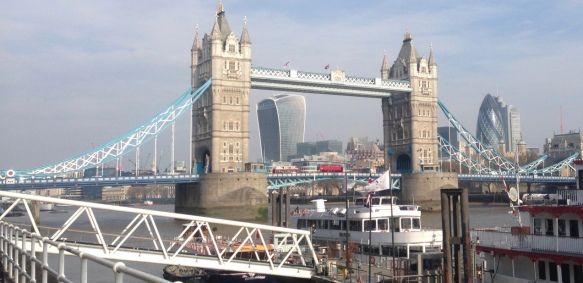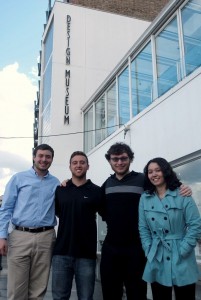
During the Spring of my Junior year – Spring 2016, I worked with a small team of other WPI students to create STEAM (Science, Technology, Engineering, Art, and Math) educational resources for for teachers and their students who are interested in the London Design Museum‘s new Designer/Maker/User exhibition.
Background
At Worcester Polytechnic Institute (WPI), all students have a junior year project called the Interactive Qualifying Project (IQP). IQPs are interdisciplinary projects that involve applied research connecting science or technology with social issues and human needs. The projects are intentionally designed to be outside a student’s major. Students generally work in groups of 2-5 students typically from different majors. Each project team is assigned at least one WPI faculty member. About half of the IQP projects teams travel off campus with a few professors and stay at WPI project centers scattered around the globe.
My team included three other students: Miya Gaskell, Anthony Campagna, and Paul Deplacido. Miya is also studying Computer Science; Anthony is studying Chemical Engineering; and Paul is studying Mechanical Engineering.
Our project sponsor was the Design Museum in London. The Design Museum is a small museum “devoted to contemporary design in every form.” While we were in London, the Museum was in the process of expanding and re-locating to a larger facility on High Street in Kensington. Currently the museum is located right next to the Tower Bridge, which made for an amazing commute.


Popup card model of the new Museum
As part of the Design Museum’s move, they are creating a new exhibition – Designer/Maker/User that focuses on the three most important parties in the process of design. The Design Museum wanted educational materials for school teachers associated with exhibition. The material package included both in-classroom materials to be used in conjunction with school field trips as well as materials teachers could use independently of visiting the museum. Our job was to develop and test these educational materials.
Over seven weeks, we worked with David Houston (the Schools Producer for Learning at the Design Museum) to develop 16 educational resources for students ages 7-14 and ran a pilot programs to test these materials. Our team’s final report (and the slides for our final presentation) are online here. I’ve also uploaded the report and slides here (Report, Presentation).
Methodology
During the academic term prior to traveling to London, we (Anthony, Paul, Miya, and I) learned about the Design Museum, researched educational theory, and explored existing educational resources and curriculum focused on making and design. We had weekly virtual meetings with David Houston to learn about what we were actually going to do in London and plan our work. We also started to work on our research paper, mostly on the background section, and drafting our project implementation plan. Of course, once we arrived in London the following academic term, our plans dramatically changed based on our meetings with project stakeholders.
Almost immediately after arriving in London, we met with more staff from the Design Museum as well as teachers at Northwood (secondary) School and Colville Primary School. We’d done a fair bit of research on the UK’s education system, but meeting in-person with the teachers (and, later, other educational professionals) was so much more informative. David joined us for the stakeholder interviews. We found having a good set of prepared questions was invaluable. We also recorded and transcribed the teacher interviews, which was fairly useful for reviewing later, but was a task we found to be a bit tedious. We also arranged with the teachers to observe a science class, which was very informative – and impressive (I certainly don’t remember learning that much chemistry in 7th grade).
Building on our prior term’s work gathering existing design-focused activities and curriculum, with the information we gained from the interviews and class observation, we started working on our lesson plans. David was very helpful coming up with a number of interesting and good ideas. We also met with other educational professionals – Rachel Craddock (at the National Gallery), Maria Rossini (at the British Science Association, which makes the CREST Awards), and Martin Webber (at the OCR examination board), who were very kind and helpful.
Deliverables

Photo of our test of the Wibble Wobble Wiggle Chair activity
We developed both
(a) classroom lesson plans (that may be used independently of museum field trips) and
(b) field trip materials (to be used by school teachers during or in conjunction with a school field trip visit).
Classroom lesson plans:
We developed two “teacher packs” – one designed for Key Stage 2 (students age 7-11) similar to upper elementary grades in the US and the other designed for Key Stage 3 (ages 11-14) similar to middle school in the US. Each of the teacher packs consist of six different lesson plans, each tied to an object (or multiple objects) in the Design Museum’s collection. The first lesson plan we finished focuses on The Wiggle Side Chair and includes a design-challenge activity where the students build a newspaper chair. To test the general format of our lesson plans, we ran a pilot program at Northwood School (at a science club) and Colville Primary School (in four consecutive art classes). Both of the pilot sessions were successful, and we learned a lot from talking to the teachers afterwards. To evaluate the effectiveness of the prototype activities and lesson plans we used multiple methods: we conducted teacher interviews, collected data using an observational rubric during the pilot sessions, and implemented a post-activity written survey with the students using customized age-appropriate survey instruments. We reviewed this data with our sponsor so that we could make changes to make the activities as effective as possible. The final group of lesson plans were:
- Simply Sugru – students redesign a classroom object and learn about engineering and design

Photo of the Crazy Kettles and Trendy Teapots prototype activity
- From the Streets to the School – students create a sign for the school and learn about civil engineering and graphic design
- Crazy Kettles and Trendy Teapots – students create a teapot out of plastic bottles and learn about materials in design
- Brains and Braun: Less, but Better – students create a paper mockup of a control system and learn about industrial design and user interfaces
- The Valiant Vespa – students construct a balloon vehicle and learn about engineering and physics
- Wibble, Wobble, Wiggle Chair – students build a newspaper chair and lean about recycling, materials, and forces
Field trip materials:
We also created museum visit-related materials for school teachers and students to use during or in conjunction with a field trip to the museum. These materials consisted of: a pre-visit lesson plan with presentation and during-visit booklet, each in two versions, one for Key Stage 2 and one for Key Stage 3. The materials are intended to be accessible from the museum’s website.
Final Presentation and Report:
Once the lessons plans and field trip materials were complete, we prepared a final presentation and report for the Design Museum and for our WPI professors and project stakeholders and advisors. We delivered our final presentation at Crossrail headquarters along with another team from WPI that created an interesting STEM program for Crossrail expanded railway system in London. The final project report including the activities is available for download as well as the final project presentation which includes photos of the different activities.
Reflections

Working with my team members Miya, Paul, and Anthony was great. Our sponsor David Houston from the Design Museum was fantastic to work with – he was encouraging and helpful and hopefully we were able to develop materials of real benefit to the Design Museum and local teachers and students.
I really enjoyed living in London – it was great to be able to explore this city on foot and using the Tube. I spent most of my free time visiting parks and museums and I also got to squeeze in a trip to the Harry Potter Studio Tour.

After the project ended
 After we finished the project, my parents traveled to London and met me for a vacation together. We visited Bletchley Park learning all about the Enigma machine, codebreaking, and even got to stand in Alan Turing’s office. Then we visited Lyme Regis where Mary Anning discovered the first ichthyosaur skeleton and many other famous fossils; we got a chance to find fossils ourselves on the beach. We then visited a friend of my parents from grad school in northern Scotland near Findhorn, and then on to the Netherlands where my father was born. We visited lots of museums, historic sites, and beautiful places – all sprinkled heavily with maritime history and technology. It was a great trip.
After we finished the project, my parents traveled to London and met me for a vacation together. We visited Bletchley Park learning all about the Enigma machine, codebreaking, and even got to stand in Alan Turing’s office. Then we visited Lyme Regis where Mary Anning discovered the first ichthyosaur skeleton and many other famous fossils; we got a chance to find fossils ourselves on the beach. We then visited a friend of my parents from grad school in northern Scotland near Findhorn, and then on to the Netherlands where my father was born. We visited lots of museums, historic sites, and beautiful places – all sprinkled heavily with maritime history and technology. It was a great trip.
Fall 2016 Update
The key stage 3 teacher pack will be in the museum shop when it opens in its new building on November 24th 2016 – the museum will be printing 500 copies initially, and will print more based on popularity. David Houston has sent me some pictures, and it looks like the designer, Sara, has done an amazing job. The key stage 2 pack is still being reviewed and the Design Museum is planning to release it in January 2017.
2017 Update
David sent me a copy of the KS3 Designing Making Using book, and it looks great! We were also mentioned in an article about the 30th anniversary of the London Project Center.


